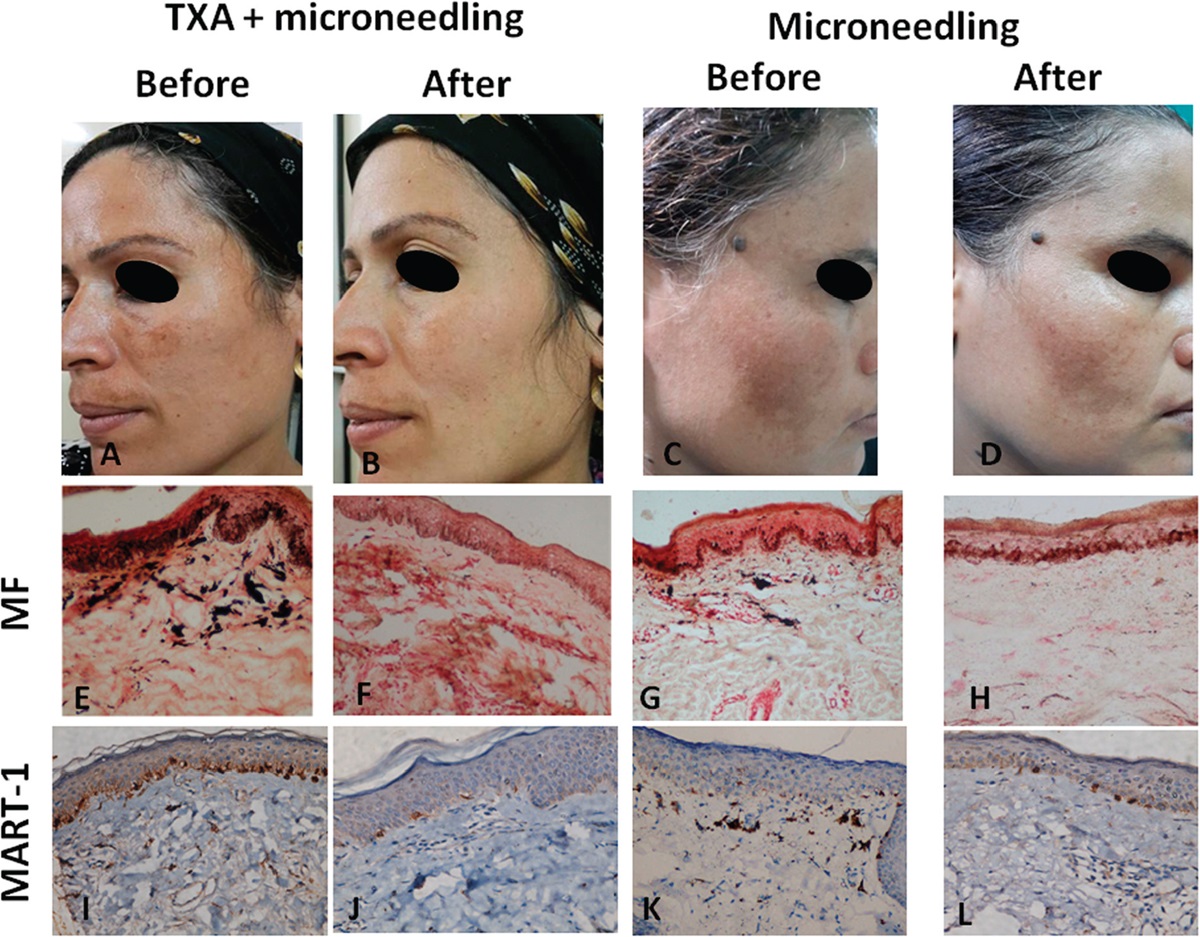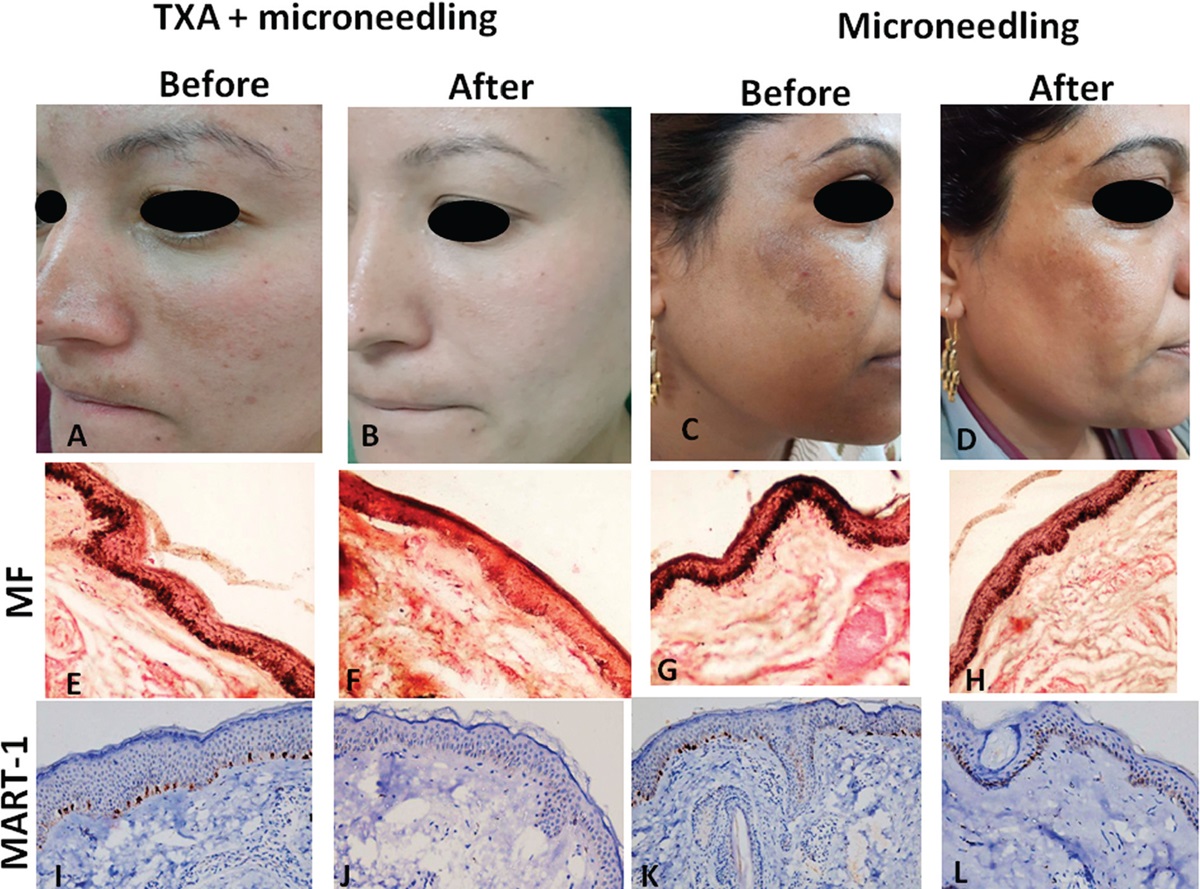A Promising Approach to Melasma Treatment: Combining Tranexamic Acid with Microneedling
Melasma is a challenging skin condition characterized by dark patches, primarily affecting sun-exposed areas of the skin. It’s not just a cosmetic concern but can significantly impact an individual’s confidence and psychological well-being. Over the years, various treatments have been tried, from topical creams to laser therapy, yet finding a consistently effective solution has yet to be discovered. However, a recent study published in the Journal of the Egyptian Women’s Dermatologic Society offers new hope. This research explores the effectiveness of combining tranexamic acid (TXA) with microneedling in treating melasma compared to microneedling alone.
Understanding Melasma and Its Traditional Treatments
Melasma is an acquired condition leading to symmetrical hyperpigmentation. It manifests as light brown to dark brown patches on the face, notably on the forehead, cheeks, and chin. Although it can affect anyone, it’s more common in women and people with darker skin types. The exact cause of melasma is still under investigation, but factors like genetic predisposition, hormonal changes (such as during pregnancy), and sun exposure are known contributors.
Book Your Free Consultation Today Or Call (647) 560-9233


Traditional Approaches to Melasma Treatment
Traditionally, treatments have ranged from topical applications, like hydroquinone and azelaic acid, to procedural interventions, including chemical peels and laser therapy. These methods aim to reduce melanin production, the pigment responsible for skin colour. However, their success rates vary, and long-term remission is hard to achieve, leading researchers to explore new treatment modalities.
The Study: Combining TXA with Microneedling
A recent study investigated whether topical TXA applied in conjunction with microneedling could be a more effective treatment for melasma than microneedling alone.
Methodology
Forty-two female patients with melasma participated in this randomized study. They were divided into two groups: one receiving six microneedling and TXA application sessions and the other undergoing six microneedling sessions. The sessions were spaced two weeks apart, allowing researchers to observe and compare the results from both treatments.
Findings
The study’s results were promising. Both groups saw a reduction in melasma’s appearance, but the combination of TXA and microneedling led to significantly better outcomes. This was evident in the visible improvement of the skin and the histological and immunohistochemical changes, indicating deeper skin healing. The combination treatment effectively reduced melanin levels and the number of cells causing the dark patches, offering a more profound and potentially longer-lasting treatment effect.
Implications and Future Directions
The study suggests that adding TXA to microneedling can enhance the treatment’s effectiveness for melasma. This combination could represent a new, more effective approach for those with limited success with traditional treatments. The process is secure and has few adverse effects, which makes it a desirable choice for numerous individuals.
Looking Ahead
Further research could help refine this treatment combination, exploring optimal dosages, session frequencies, and long-term outcomes. As the search for effective melasma treatments continues, this study adds an important piece to the puzzle, suggesting a new direction that could help many individuals find relief from this persistent condition.
In conclusion, combining TXA with microneedling shows significant promise in treating melasma, offering new hope for those affected by this challenging skin condition. The combination therapy has shown encouraging outcomes with few adverse effects, making it a potentially favoured choice for patients and dermatologists to consider in future investigations.
Q&A
- What is melasma, and who will most likely be affected?
Melasma is a skin condition characterized by symmetrical hyperpigmentation, or dark patches, primarily on sun-exposed areas of the face such as the forehead, cheeks, and chin. It is more common in women, particularly those in their reproductive years, and is often seen in individuals with darker skin types, showing particular prominence among Hispanics and Asians.
- What causes melasma?
The precise origins of melasma remain elusive. Yet, it’s thought to arise from inherited traits, hormonal fluctuations (like those experienced in pregnancy or with hormone treatments), and exposure to sunlight. These elements lead to excess production of melanin, the pigment that gives skin its colour, which in turn causes the distinctive dark spots associated with the condition.
- How has melasma traditionally been treated?
Traditional treatments for melasma include topical medications like hydroquinone, azelaic acid, and corticosteroids; procedural treatments such as chemical peels, microdermabrasion, and various types of laser therapy; and light-based devices. These treatments aim to reduce melanin production in the affected areas, but their effectiveness can vary, and achieving long-term remission has been challenging.
- What new treatment approach was explored in the recent study published in the Journal of the Egyptian Women’s Dermatologic Society?
The recent study explored a new treatment approach combining tranexamic acid (TXA), a synthetic lysine derivative known for its ability to reduce bleeding, with microneedling, compared to microneedling alone. This combination was investigated for its effectiveness in treating melasma, focusing on visible improvements and changes at a microscopic level in the skin.
- What were the study’s findings on combining TXA with microneedling for melasma treatment?
The study found that both treatments—microneedling alone and in combination with TXA—helped reduce the appearance of melasma. However, the combination of TXA and microneedling resulted in significantly better outcomes, including a more significant reduction in melanin levels and the number of cells contributing to the dark patches, suggesting a more profound and potentially longer-lasting effect.
- Are there any side effects associated with the combined TXA and microneedling treatment for melasma?
The study reported minimal side effects associated with the combined treatment, including slight transient erythema (redness of the skin) and a burning sensation experienced by some patients a few hours after the sessions. These side effects were generally well-tolerated, indicating a good safety profile for the procedure.
- What does the future hold for the treatment of melasma based on the study’s findings?
The promising results of combining TXA with microneedling suggest that this option is preferred for treating melasma, offering new hope for those affected. Further research is needed to optimize the treatment protocol, determine long-term outcomes, and explore the potential for achieving lasting remission. This combination treatment with microneedling and TXA represents an exciting development in the ongoing effort to find more effective solutions for managing melasma.
Melasma Treatment Plan at Laser Skin Clinic
Preparation for Skin Enhancement 2 – 4 Weeks Before Microneedling:
- Morning and evening, cleanse with Enzyme Cleanser.
- In the morning, apply Chebula Skin Renew Antioxidant Serum.
- Protect your skin in the morning with Sun Protect Chebula Moisturizer containing 25% Zinc Oxide.
- Use Micro-Peel Crème 2-3 times weekly in the evening.
- At night, use Chebula Tranexamic Acid Pigmentation Serum.
Procedure:
Initial Steps:
- Thoroughly wash the face with Enzyme Cleanser to remove all traces of makeup, possibly cleansing twice for heavy makeup. Rinse off the cleanser with lukewarm water and gently dry.
Main Treatment:
- Spread a layer of Chebula Tranexamic Acid Pigmentation Serum on the face. As you proceed with the treatment, add more to keep the skin lubricated.
- Carry out Microneedling or Plasma Pen Treatment, avoiding the eye area.
- Massage any excess serum into the skin.
Aftercare:
- Apply Copper Co-Enzyme Q10 to moisturize and aid in recovery.
- Follow up with Sun Protect.
- The client should avoid direct sunlight for the next 48 hours.
Home Care Post-Procedure:
- Cleanse with Enzyme Cleanser both in the morning and evening.
- In the morning, apply Chebula Skin Renew Antioxidant Serum.
- Use Sun Protect Chebula Moisturizer with 25% zinc oxide in the morning.
- In the evening, apply Chebula Tranexamic Acid Pigmentation Serum.
- At night, use Chebula Overnight Brightening Mask.
